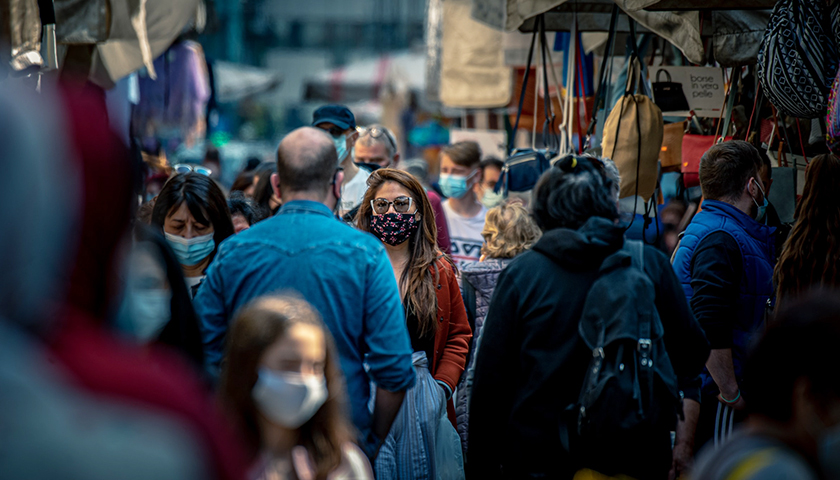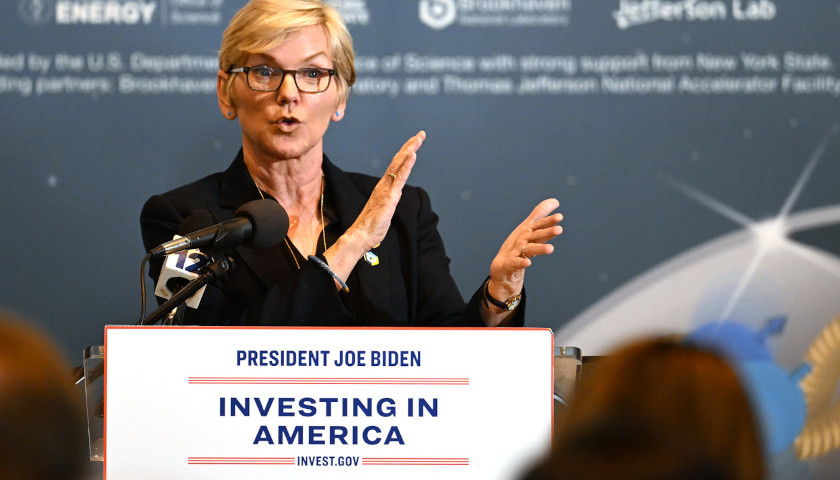Authors of new research published by Innovations for Poverty Action (IPA) Bangladesh, which tracked mask-wearing among 340,000 Bangladeshi adults, claim the results show mask usage can considerably reduce the spread of symptomatic COVID-19.
Some medical professionals, however, say mask mandates in schools have potentially negative impacts on children’s learning and social health.
The IPA Bangladesh analysis, conducted by a team from Yale University, Stanford University, and Johns Hopkins University, among other institutions, is reportedly the largest randomized control study examining masking’s efficacy for stanching the transmission of the novel coronavirus. The study is now undergoing peer review by the journal Science.
The research team reported that mask-wearing increased by 28.8 percent after a group of Bangladeshis were exhorted to wear masks. Researchers then observed that confirmation of COVID-19 infection was reduced by 9.3 percent in this group and that COVID-19 symptoms were reduced by 11.9 percent.
Critics of mask mandates have heretofore expressed concern about the lack of randomized controlled trials (RCTs) regarding masks’ effectiveness. In RCTs, subjects are selected on a random basis to mask or not mask, allowing rates of infection to be objectively compared between the two groups.
A review last month by statistician Jeffrey H. Anderson in the Manhattan Institute’s City Journal of the few RCTs studying masks’ ability to prevent viral spread concluded that face coverings are “useless … or actually counterproductive.”
Speaking to The Washington Post, Jason Abaluck, a Yale economist and a lead author of the IPA Bangladesh study was triumphalist in his assessment of what his research means for masking policy. “I think this should basically end any scientific debate about whether masks can be effective in combating COVID at the population level,” he said.
But other scientists have urged caution when it comes to imposing mask mandates in public settings, particularly schools.
“The potential educational harms of mandatory-masking policies are much more firmly established, at least at this point, than their possible benefits in stopping the spread of COVID-19 in schools,” epidemiologist Vinay Prasad of the University of California-San Francisco recently wrote in The Atlantic.” To justify continued masking of schoolchildren – with no end date in sight – we have to prove that masks benefit kids, and at what ages. States and communities that are considering masking policies just to be safe should recognize that being overly cautious has a cost, while the benefits are uncertain.”
Prasad’s article notes at the outset that U.S. children under the age of 17 have been hospitalized for coronavirus infections at much lower rates than Americans of any other age group. While 3.65 in 100,000 Americans of all ages have been newly hospitalized with COVID as of Sept. 2, only 0.5 in 100,000 American children under 17 have been.
 The epidemiologist also urged those impressed by the IPA Bangladesh research to consider that its authors did not analyze masking’s effect on viral spread among children. What research does exist on that subject, he observed, appears indeterminate at best. In Spain, for instance, masks are required in schools for all children ages six and above; yet COVID transmission has increased with age among Spanish students, showing no drop among the age cohorts who are compelled to mask.
The epidemiologist also urged those impressed by the IPA Bangladesh research to consider that its authors did not analyze masking’s effect on viral spread among children. What research does exist on that subject, he observed, appears indeterminate at best. In Spain, for instance, masks are required in schools for all children ages six and above; yet COVID transmission has increased with age among Spanish students, showing no drop among the age cohorts who are compelled to mask.
Meanwhile, writes Prasad, research does suggest that depriving schoolchildren of facial cues for extended lengths of time is detrimental to their education and socialization. He nonetheless concedes the matter “has been difficult to assess systematically because, until this pandemic, face-covering policies were never previously imposed on so many children for such a long period of time.”
Some scientific analysis does, however, shed light on the matter. A 2020 study by Claus-Christian Carbon, a professor of psychology at the University of Bamberg in Germany, determined that “lower accuracy and lower confidence in one’s own assessment of… emotions [displayed during one’s mask use] indicate that [observers’] emotional reading was strongly irritated by the presence of a mask.” Carbon’s examination “further detected specific confusion patterns, mostly pronounced in the case of misinterpreting disgusted faces as being angry plus assessing many other emotions (e.g., happy, sad, and angry) as neutral.”
The drawbacks to forcing students to mask has been sufficiently compelling that the World Health Organization, which recommends masking for children ages 12 and older, has explicitly advised against requiring masks for those under age six. That’s in contrast to the policy of the U.S. Centers for Disease Control and Prevention (CDC) and the American Academy of Pediatrics (AAP), both of which say those age two and older ought to wear masks in community settings.
And although the CDC recommends that caregivers who work in infant day-care centers wear masks irrespective of vaccination status, health authorities in many other countries have rejected that policy in favor of babies being able to see caregivers faces. Prior to the emergence of COVID-19, the AAP took a similar view favoring the importance of seeing faces in that setting.
– – –
Bradley Vasoli is a reporter at The Tennessee Star and The Star News Network. Follow Brad on Twitter at @BVasoli. Email tips to [email protected].





